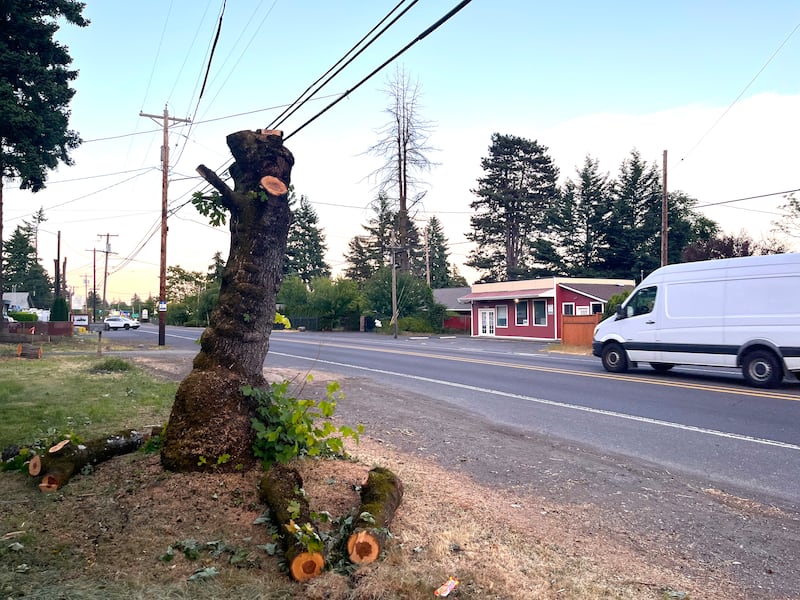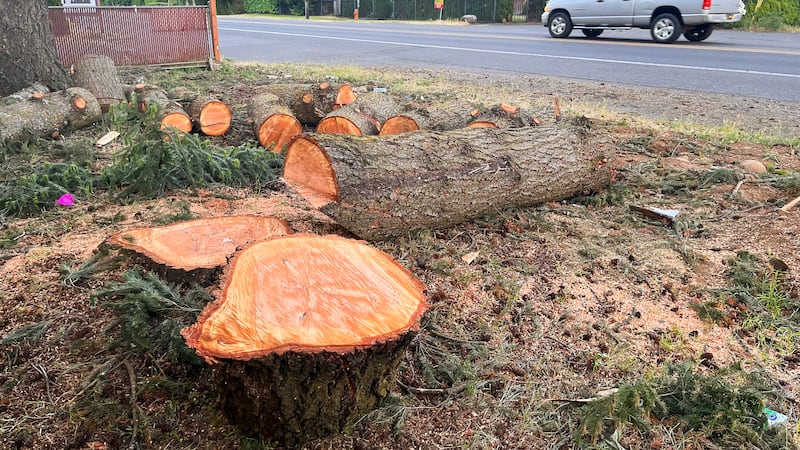People living near Southeast Powell Boulevard have asked for sidewalks and more traffic lanes for nearly 20 years. Soon, state transportation officials will be giving them just that: wider blacktop and new sidewalks along 67 blocks of the arterial road as it runs east from Interstate 205 into Gresham.
But widening the right of way will also thin the surrounding tree canopy along Powell—an increasingly precious resource in the heat islands of East Portland. The project’s scope includes chopping down at least 570 trees, WW has learned.
When Stephen Karmol first saw workers in bright orange vests chopping down trees at the end of his street in the Powellhurst-Gilbert neighborhood, he couldn’t help but be upset.
“I was pretty heartbroken, honestly,” Karmol says. “The trees were huge and old and beautiful.”
The massive Douglas firs are one of the reasons Karmol moved to the neighborhood 10 years ago. The trees help protect Portlanders from potentially deadly heat waves, like the one in 2021 that killed 69 Portlanders, roughly 18 of whom lived east of I-205.
Such heat waves are becoming increasingly common in Portland, and research shows that neighborhoods in East Portland, particularly those east of I-205, can be 25 degrees hotter than parts of the forested Northwest Hills during major heat events. That’s because East Portland’s tree canopy is less than half the size of the canopy west of the Willamette River.
That places pedestrian and traffic safety at odds with tree preservation—two key objectives for the eastern edge of the city, both intended to remedy decades of City Hall neglect of East Portland.
“We have a heat island effect going on out there that makes it particularly brutal when the temperatures get really, really hot around here,” says Ethan Seltzer, an emeritus professor of urban studies at Portland State University. “The question comes down to, given the goals for the project, is the only solution taking out all those trees?”

Jim Chasse lives in Powellhurst-Gilbert less than a block from Southeast Powell Boulevard. On a sunny Thursday, Chase points to a sidewalk across the street from his home. It’s the only sidewalk in the neighborhood, he says, despite hundreds of children walking every day to West Powellhurst Elementary just a few blocks down the street.
“There are no safe routes to school because there’s no sidewalks,” Chasse says. “A third of the kids live south of Powell. They have to cross the street, and there’s no place to cross.”
The state’s Outer Powell Transportation Safety Project was born of two decades of neighborhood concerns about the road’s dangers.
It was not until the 1980s that stretches of Powell included in the current project were annexed by the city of Portland. (Prior to piecemeal annexation, what is now East Portland was managed by Multnomah County.) Even now, 40 years after annexation, this part of the city lacks transportation infrastructure present in other parts of Portland.
The Outer Powell project, which the state estimates will cost more than $105 million by its completion in 2027, will widen the right of way from 56 to 76 feet. It will add a third lane in the middle of the road for turning as well as safe crossings, sidewalks and concrete walls in some residential areas to protect residents from traffic noise.
The city of Portland contributed to a portion of the construction already completed along a 14-block stretch of Powell, but the upcoming construction farther east is entirely state funded. Most of that money comes from a bill passed by the Oregon Legislature in 2017 that sought to invest $5.3 billion in transportation infrastructure across the state over 10 years.
Seltzer says that such projects to make Powell safer are critical. After all, along Powell between I-205 and 174th Avenue last year, two drivers died in car crashes, seven were seriously injured, and hundreds of others suffered minor injuries, according to Portland transportation officials. The intersection at 122nd Avenue and Powell, which has already been improved with a third lane and sidewalks on both sides, had the 15th-highest rate of cars hitting pedestrians in the city last year.
“Despite the fact that Division Street is a blown-out street with all kinds of lanes, especially east of 92nd Avenue, people have continued to use Powell as a major east-west route,” Seltzer says. “There are safety issues on the street, which is narrow and has had limited improvements for pedestrians.”
The Oregon Department of Transportation has already begun preparation to break ground. Among the obstacles to remove: 572 trees that offer shade to homeowners and renters in the already overheated area.
Shelli Romero, an ODOT manager for the metro area, says the tree removals were primarily to accommodate space for sidewalks, create greater visibility at safe crossings, and root networks that interfered with underground utilities, like water pipes.
Nevertheless, the loss of more than 570 trees concerns Dr. Vivek Shandas, who studies and maps the impacts of climate change at PSU.
“From 2014 to 2020, we’ve observed a marked decline in the tree canopy in East Portland,” Shandas says. “It’s an area that has lost more tree canopy than any other part of the city.”
Trees are a form of climate change-fighting infrastructure, Shandas argues. They provide shade that keeps cars, roads and buildings cool, and they bring in moisture.
Concrete, asphalt and metal retain heat and then radiate that heat out at night, preventing the area from cooling down. Each morning, heat rises from the pavement because the road hasn’t cooled off completely.
Shandas says the loss of hundreds of trees around Powell—and the laying of more pavement to widen the roadways—will make the surrounding area as much as 10 degrees hotter.
The state will have to replant trees as part of the project or pay into the city’s tree planting and preservation fund that plants trees around Portland. But there is no way of knowing the trees will make their way back to the Powellhurst-Gilbert neighborhood; officials could only point WW to a list of neighborhoods where the city prioritizes tree planting.
“Several of them are being replanted,” says Jennifer Bachman, ODOT manager for the project. “For the ones that can’t be replanted along this corridor specifically, then ODOT pays into the general tree canopy funds for the city to replant trees around the city as they see fit.”
Even if those trees are planted soon, Shandas says, it’s difficult to say how long it will take for a newly planted tree to fill the hole left by the older trees that were cut down.
Chasse, for his part, says the city and state are doing the right thing by expanding the street—even if it means chopping down greenery that helps shade his neighborhood from the sun.
“The trees,” he says, “will grow back.”
